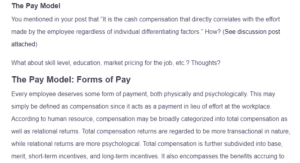The Pay Model
You mentioned in your post that “It is the cash compensation that directly correlates with the effort made by the employee regardless of individual differentiating factors.” How? What about skill level, education, market pricing for the job, etc.? Thoughts?
Thank you for your response. “Base wage is the cash compensation that directly correlates with the effort made by the employee regardless of individual differentiating factors.” What I meant by this is base wage generally reflects the value of the work performed, ignoring employees’ varying attributes like experience and educational qualification. For example, the base wage for a certain class of employees might be $40 an hour, disregarding the experience or educational background of two different employees in this class (George & Newman, 2011).
I agree with you. Various factors, such as skill level, education, market pricing for the job, etc., determine the employee’s cash compensations, such as base wage, merit pay/cost-of-living adjustments, and incentives. These compensations are determined at the stage of recruitment. At this phase, the HR managers analyze an individual’s experience, qualifications, education, and other aspects that make an employee more valuable to an organization. Take, for instance, a manager and a subordinate employee. The manager receives a higher pay because they have more experience, educational qualifications, and skills, and have been in a similar position in the past. These aspects predispose the manager to carry out their roles efficiently (HR-Guide, LLC, 2015). The subordinate employee is also qualified but for a lower position than the manager’s.
What I was referring to in my statement was employees in the same category/class. Both employees will receive the same base wage regardless of their skills and qualifications. For example, two service technicians at a vehicle dealership performing the same roles will receive the same rate per hour. One technician might have more years of experience in the role and higher qualifications, but since both technicians are at a similar level, their hourly rate will be the same. However, their total cash compensations might differ due to other cash compensations like merit pay/cost-of-living adjustments and incentives, which might be determined using other attributes like experience and education level.
References
HR-Guide, LLC. (2015). Compensation: Outline and Definitions.
Milkovich, G. T., & Newman, J. M. (2011). Compensation (11th ed.). McGraw Hill Irwin.
ORDER A PLAGIARISM-FREE PAPER HERE
We’ll write everything from scratch
Question
The Pay Model
You mentioned in your post that “It is the cash compensation that directly correlates with the effort made by the employee regardless of individual differentiating factors.” How? (See discussion post attached)

The Pay Model
What about skill level, education, market pricing for the job, etc.? Thoughts?
The Pay Model: Forms of Pay
Every employee deserves some form of payment, both physically and psychologically. This may simply be defined as compensation since it acts as a payment in lieu of effort at the workplace. According to human resource, compensation may be broadly categorized into total compensation as well as relational returns. Total compensation returns are regarded to be more transactional in nature, while relational returns are more psychological. Total compensation is further subdivided into base, merit, short-term incentives, and long-term incentives. It also encompasses the benefits accruing to employment, such as income protection, work balance and allowances. Base wage is the foundational compensation from where all other modes of compensation build. It is the cash compensation that directly correlates with the effort made by the employee regardless of individual differentiating factors. Adjustments to base wage give rise to other forms of cash compensation, such as merit compensation that is attributable to changes in the cost of living as well as change in skill. Incentives depend on performance, while benefits vary on the type of responsibility allocated. In my past workplaces, I have experienced both the base and allowances forms of pay. Both forms of pay positively impacted my work morale and motivation.
The different modes of compensation optimally contribute to the organizational going concern. Different modes of payment affect the employee motivation and zeal in the performance of their duties. Achievement of the desired organizational goals largely depends on the proper management of the human resource aspect. An unfair mode of compensation can sparkle a turnover intention amongst employees. This is the desire to leave the organization through resignation or dismissal. Avoidable voluntary turnover is caused by salaries not matching the level of skills and the individual contribution to the organization. Irregular payment modes could also put the organization at risk of competitive pay scales from other organizations, thus leading to high employee turnover through absorption. Regular employee appreciation through bonuses and allowances encourages them and positively affects output.
References
Milkovich, G., Newman, J., Gerhart, B. (2014) Compensation. McGraw-Hill Irwin Companies. 13-17.
Muller, F. (2020). Compensation in Multinational Companies. Models and Objectives.

